The Level Floats Market is estimated to be valued at USD 311.9 million in 2025 and is projected to reach USD 461.7 million by 2035, registering a compound annual growth rate (CAGR) of 4.0% over the forecast period.
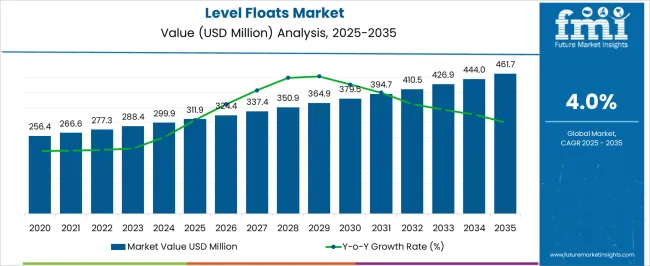
| Metric | Value |
|---|---|
| Level Floats Market Estimated Value in (2025 E) | USD 311.9 million |
| Level Floats Market Forecast Value in (2035 F) | USD 461.7 million |
| Forecast CAGR (2025 to 2035) | 4.0% |
The Level Floats market is experiencing steady growth, driven by the rising demand for precision fuel measurement systems across automotive and industrial applications. Increasing adoption of advanced fuel management technologies and stringent emission regulations are encouraging manufacturers to integrate reliable level float solutions in fuel tanks and storage systems.
The market’s growth is further supported by the expansion of passenger vehicle production and the rising focus on safety and operational efficiency in automotive components. Improvements in material science and sensor technologies are enabling the production of durable and accurate level floats, which are critical for ensuring consistent performance and long-term reliability.
As automotive OEMs continue to emphasize high-quality components for both internal combustion engines and hybrid systems, the need for robust and customizable level floats is projected to remain strong The future outlook is shaped by ongoing innovations that enhance compatibility with electronic fuel monitoring systems, reduce maintenance requirements, and improve environmental compliance, thereby creating significant opportunities for growth in both developed and emerging markets.
The level floats market is segmented by material type, sales channel, application, and geographic regions. By material type, level floats market is divided into Metallic and Non-Metallic. In terms of sales channel, level floats market is classified into Original Equipment Manufacturers and Aftermarket. Based on application, level floats market is segmented into Passenger Cars, Automotive, Two Wheelers, Hybrid Electric Vehicles, Light Commercial Vehicles, Heavy Commercial Vehicles, Industrial Equipment, Boilers, Industrial Level Gauges, Piping Instruments, Generators, and Others. Regionally, the level floats industry is classified into North America, Latin America, Western Europe, Eastern Europe, Balkan & Baltic Countries, Russia & Belarus, Central Asia, East Asia, South Asia & Pacific, and the Middle East & Africa.
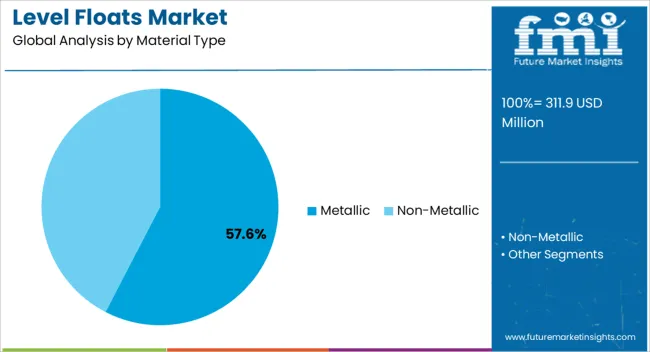
The metallic material type segment is expected to hold 57.60% of the Level Floats market revenue in 2025, positioning it as the leading material type. This dominance is being driven by the inherent durability, resistance to wear, and long-term stability offered by metallic components in fuel environments.
Adoption has been facilitated by their compatibility with a wide range of fuel formulations, including gasoline and diesel, without compromising accuracy or reliability. The segment has benefited from the preference of OEMs for materials that can withstand high temperatures, corrosion, and mechanical stress over prolonged periods.
The precision manufacturing of metallic level floats allows seamless integration with both traditional and modern fuel management systems, reducing the likelihood of measurement errors and maintenance needs Future growth is expected to be supported by ongoing developments in lightweight and corrosion-resistant alloys, which provide improved performance while supporting fuel efficiency initiatives and regulatory compliance across global automotive markets.
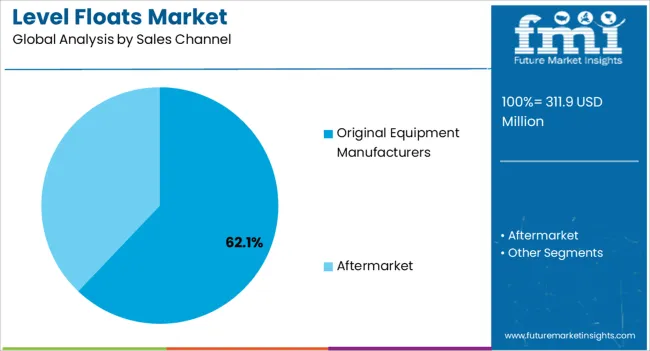
The original equipment manufacturers sales channel segment is projected to account for 62.10% of total market revenue in 2025, making it the largest distribution channel. This segment’s growth has been driven by the strong preference of vehicle manufacturers for sourcing high-quality level floats directly from trusted suppliers.
OEM partnerships ensure that level floats meet stringent performance, safety, and durability standards required for integration into passenger cars and commercial vehicles. The direct supply model reduces the risk of counterfeit or substandard components and allows manufacturers to implement custom specifications that enhance vehicle fuel system performance.
Increasing collaboration between OEMs and float manufacturers has facilitated innovations in sensor compatibility, corrosion resistance, and precise calibration As vehicle production scales in emerging markets and technological adoption in automotive components grows, the OEM channel is anticipated to maintain its leading position by ensuring consistent product quality and fostering long-term supplier relationships, which are critical for market stability and reliability.
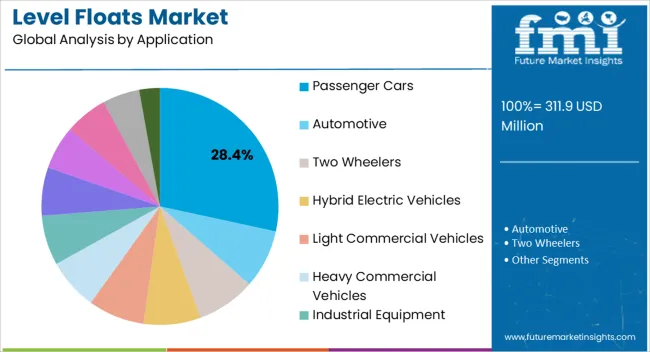
The passenger cars application segment is expected to hold 28.40% of the Level Floats market revenue in 2025, making it the leading application segment. This predominance is being driven by the high production volumes of passenger vehicles globally and the increasing incorporation of fuel-level monitoring systems in modern cars. Level floats are critical for accurate fuel measurement, which directly impacts vehicle efficiency, emissions compliance, and overall safety.
Growth has been accelerated by advancements in electronic fuel monitoring technologies that require precise and durable float components. Manufacturers of passenger cars are increasingly demanding level floats that can be integrated seamlessly into fuel tanks while maintaining high accuracy under varying operating conditions.
The segment has also benefited from rising consumer expectations for fuel efficiency and real-time fuel management information, which encourages the adoption of high-quality, software-compatible float systems Future growth is expected to continue as passenger car production expands in both mature and emerging markets, and as automotive OEMs focus on enhancing vehicle performance and reliability through superior fuel measurement technologies.
A level floats is one of the important part of a fuel system which is used for the measurement of the fuel level. The level of the fuel is measured with the up and down movement of the fuel in the fuel tank. It is prerequisite for the level floats to be excellent in terms of durability and oil resistance as they are used in fluids such as gasoline, diesel, etc.
A level floats is an important device which helps the user to know the level of fuel in the tank. Level floats is used effectively so that the consumers can know when they need to refill next. A level floats is installed inside the fuel tank and can connected to the fuel meter through series of cables & wires. Nowadays, sensors are also used to transmit the fuel level signals to the digital fuel meter, but many argue that are less accurate in comparison to the conventional wired system.
Some of the protuberant factors for the growth of the level floats market is the increasing vehicle production globally and the enhancement of safety features. The level floats market is mostly being driven by the increasing production of PCV, luxury, sports and LCV vehicles in the global market. A level floats has to be changed checked regularly and replaced if damage or leakage is found so that it can perform its work efficiently. Additionally, these level floats have the ability to endure all the weather condition as well as have strong corrosion resistance properties.
The continuous increase of vehicle electronics and connected car concept is also estimated to remain one of the most prominent drivers in the global level floats market. The rising awareness of safety and comfort among the consumers, is also forcing the key manufacturers for technological advancements for the development of efficient level floats in the global market.
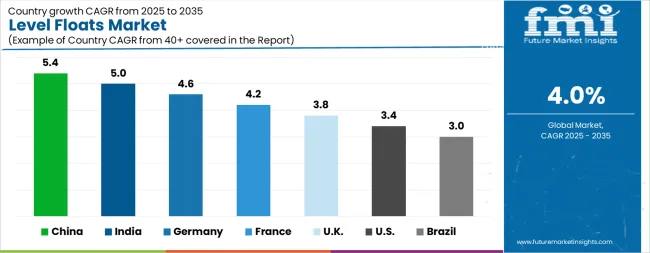
| Country | CAGR |
|---|---|
| China | 5.4% |
| India | 5.0% |
| Germany | 4.6% |
| France | 4.2% |
| UK | 3.8% |
| USA | 3.4% |
| Brazil | 3.0% |
The Level Floats Market is expected to register a CAGR of 4.0% during the forecast period, exhibiting varied country level momentum. China leads with the highest CAGR of 5.4%, followed by India at 5.0%. Developed markets such as Germany, France, and the UK continue to expand steadily, while the USA is likely to grow at consistent rates. Brazil posts the lowest CAGR at 3.0%, yet still underscores a broadly positive trajectory for the global Level Floats Market. In 2024, Germany held a dominant revenue in the Western Europe market and is expected to grow with a CAGR of 4.6%. The USA Level Floats Market is estimated to be valued at USD 115.5 million in 2025 and is anticipated to reach a valuation of USD 161.4 million by 2035. Sales are projected to rise at a CAGR of 3.4% over the forecast period between 2025 and 2035. While Japan and South Korea markets are estimated to be valued at USD 15.9 million and USD 8.9 million respectively in 2025.
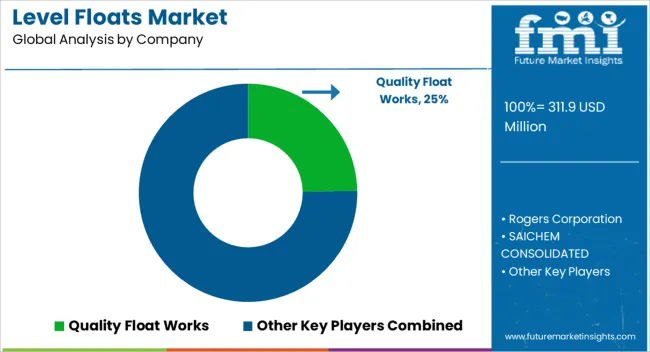
| Item | Value |
|---|---|
| Quantitative Units | USD 311.9 Million |
| Material Type | Metallic and Non-Metallic |
| Sales Channel | Original Equipment Manufacturers and Aftermarket |
| Application | Passenger Cars, Automotive, Two Wheelers, Hybrid Electric Vehicles, Light Commercial Vehicles, Heavy Commercial Vehicles, Industrial Equipment, Boilers, Industrial Level Gauges, Piping Instruments, Generators, and Others |
| Regions Covered | North America, Europe, Asia-Pacific, Latin America, Middle East & Africa |
| Country Covered | United States, Canada, Germany, France, United Kingdom, China, Japan, India, Brazil, South Africa |
| Key Companies Profiled | Quality Float Works, Rogers Corporation, SAICHEM CONSOLIDATED, Naigai Rubber Industry, Kecy Metal Technologies, ARTHUR HARRIS, D.K. Instruments Pvt. Ltd, and Stainless Steel Float Balls |
The global level floats market is estimated to be valued at USD 311.9 million in 2025.
The market size for the level floats market is projected to reach USD 461.7 million by 2035.
The level floats market is expected to grow at a 4.0% CAGR between 2025 and 2035.
The key product types in level floats market are metallic and non-metallic.
In terms of sales channel, original equipment manufacturers segment to command 62.1% share in the level floats market in 2025.






Our Research Products

The "Full Research Suite" delivers actionable market intel, deep dives on markets or technologies, so clients act faster, cut risk, and unlock growth.

The Leaderboard benchmarks and ranks top vendors, classifying them as Established Leaders, Leading Challengers, or Disruptors & Challengers.

Locates where complements amplify value and substitutes erode it, forecasting net impact by horizon

We deliver granular, decision-grade intel: market sizing, 5-year forecasts, pricing, adoption, usage, revenue, and operational KPIs—plus competitor tracking, regulation, and value chains—across 60 countries broadly.

Spot the shifts before they hit your P&L. We track inflection points, adoption curves, pricing moves, and ecosystem plays to show where demand is heading, why it is changing, and what to do next across high-growth markets and disruptive tech

Real-time reads of user behavior. We track shifting priorities, perceptions of today’s and next-gen services, and provider experience, then pace how fast tech moves from trial to adoption, blending buyer, consumer, and channel inputs with social signals (#WhySwitch, #UX).

Partner with our analyst team to build a custom report designed around your business priorities. From analysing market trends to assessing competitors or crafting bespoke datasets, we tailor insights to your needs.
Supplier Intelligence
Discovery & Profiling
Capacity & Footprint
Performance & Risk
Compliance & Governance
Commercial Readiness
Who Supplies Whom
Scorecards & Shortlists
Playbooks & Docs
Category Intelligence
Definition & Scope
Demand & Use Cases
Cost Drivers
Market Structure
Supply Chain Map
Trade & Policy
Operating Norms
Deliverables
Buyer Intelligence
Account Basics
Spend & Scope
Procurement Model
Vendor Requirements
Terms & Policies
Entry Strategy
Pain Points & Triggers
Outputs
Pricing Analysis
Benchmarks
Trends
Should-Cost
Indexation
Landed Cost
Commercial Terms
Deliverables
Brand Analysis
Positioning & Value Prop
Share & Presence
Customer Evidence
Go-to-Market
Digital & Reputation
Compliance & Trust
KPIs & Gaps
Outputs
Full Research Suite comprises of:
Market outlook & trends analysis
Interviews & case studies
Strategic recommendations
Vendor profiles & capabilities analysis
5-year forecasts
8 regions and 60+ country-level data splits
Market segment data splits
12 months of continuous data updates
DELIVERED AS:
PDF EXCEL ONLINE
Level Sensor Market Size and Share Forecast Outlook 2025 to 2035
Level Transmitter Market Growth – Trends & Forecast 2025 to 2035
Level Switches Market Growth - Trends & Forecast 2025 to 2035
Level Measuring Instrument Market
Low-Level Order Picker Pallet Truck Market Size and Share Forecast Outlook 2025 to 2035
Oil Level Switches Market
Lane-level Navigation Market Size and Share Forecast Outlook 2025 to 2035
Wafer Level Packaging Market Size and Share Forecast Outlook 2025 to 2035
Float Level Switches Market Size and Share Forecast Outlook 2025 to 2035
Sound Level Measurement Meter Market Size and Share Forecast Outlook 2025 to 2035
Sound Level Meter Market Size and Share Forecast Outlook 2025 to 2035
Panel Level Packaging Market Analysis by Materials and Technologies Through 2025 to 2035
Radar Level Transmitter Market Analysis - Growth & Forecast 2025 to 2035
Water Level & Storage Monitoring Software Market
Surface Levelling Equipment Market Size and Share Forecast Outlook 2025 to 2035
Chassis Leveling Valves Market Growth - Trends & Forecast 2025 to 2035
Vibration Level Switch Market Analysis by Technology, Industry, Application, and Region through 2035
Fan-Out Wafer Level Packaging Market Size and Share Forecast Outlook 2025 to 2035
Optical Liquid Level Sensor Market Size and Share Forecast Outlook 2025 to 2035
Acid Filling and Leveling Machine Market Size and Share Forecast Outlook 2025 to 2035

Thank you!
You will receive an email from our Business Development Manager. Please be sure to check your SPAM/JUNK folder too.
Chat With
MaRIA